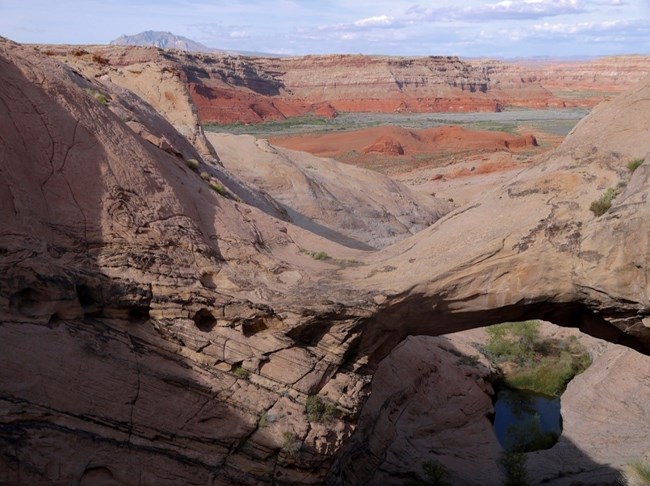Part of a series of articles titled NRCA 2022: Condition of Glen Canyon's Tributary Rivers and Associated Resources.
Article
Water in the Rock: Tinajas in Glen Canyon
Large or small, tinajas are important resources for animals, such as amphibians, aquatic invertebrates, and mammals, in Glen Canyon. Historically, they were also vital sources of water for Indigenous communities. Visitors today may drink purified water from tinajas while backcountry camping.
You may now be wondering how many tinajas are in Glen Canyon National Recreation Area (NRA) and where you can find them. Read on to learn more!
Glen Canyon tinajas
Tinajas are common throughout Glen Canyon NRA—they are the most numerous and widespread sources of surface water away from Lake Powell. They are especially prevalent in the Waterpocket Fold area (located along the border with Capitol Reef National Park [NP]). We know tinajas are important, but there have been few studies of this resource in Glen Canyon.

NPS Photo
What are the biggest threats to tinajas?
- Climate change: Climate change (drier and warmer conditions) will affect the amount and persistence of water in tinajas.
- Human disturbance: Human disturbance (visitor use and cattle) can affect the health of tinajas by degrading water quality, introducing non-native species, and affecting the occurrence of aquatic life and plants. Visitor use can lead to contamination of water from personal care products (such as sunscreen, bug spray) and Escherichia coli (E. coli). Livestock may also introduce E. coli. Both humans and cattle can trample vegetation at tinajas.
Assessing conditions of tinajas and other resources at Glen Canyon
A recent Natural Resource Condition Assessment (NRCA) through the NPS NRCA Program focused on water-related resources located away from Lake Powell and the mainstem Colorado River. NRCAs evaluate natural resource conditions so that parks can use the best available science to manage their resources. Tinajas were one of five focal resources selected for this project. Due to the limited amount of information available on tinajas, ecologists at Utah State University:
- summarized what is known about tinajas in the park and at nearby Capitol Reef NP,
- mapped the potential for tinaja occurrence in one area of the park (Waterpocket Fold area) using geology and vegetation data and aerial images. They mapped individual tinajas and large clusters (areas with more than 10 tinajas), and
- identified potential indicators of tinaja condition for future study and monitoring.
What we learned
- According to the mapping effort, there are 311 square miles within the park (areas with erodible sandstone) that may contain tinajas.
- The study identified 588 individual tinajas and 47 tinaja clusters in the Waterpocket Fold study area. Most features occurred on the east side of the fold in large clusters that appeared to be shallow with some vegetation. There are probably many more tinajas that were not observable with the methods used.
- Utah State University ecologists suggested four potential indicators of tinaja condition for future study and monitoring—water quantity, water quality, community composition, and disturbance. They also recommended surveys of vertebrates (such as amphibians) and invertebrates (such as fairy shrimp, snails, insects).
What else do we know about tinajas near Glen Canyon NRA?
Studies on tinajas at Capitol Reef NP, which borders Glen Canyon NRA, provide information that may apply to Glen Canyon’s tinajas as well. These studies include information on tinaja pool volume, vegetation, and vertebrate and invertebrate inhabitants. For example, more than half of 463 tinajas surveyed in Capitol Reef contained plants, and a total of 91 plant species were recorded. Also, vertebrate species documented in Capitol Reef’s tinajas consisted of five native amphibians and one non-native fish species. More than 50 macroinvertebrate species were recorded, including fairy shrimp (Streptocephalus texanus), pond snails (Physella spp.), and many different insects.
...

What can park managers do with NRCA information?
This NRCA study can be used to inform park planning and management actions that involve tinajas. From the study, it’s clear the park needs additional information on this valuable resource. Also:- The mapping effort that shows potential tinaja locations for a small area of the park is useful, and mapping the park’s remaining area for additional locations may be warranted.
- Study results can be used to prioritize the larger tinajas for monitoring and/or management. Larger tinajas hold more water for a longer time and are especially important during droughts.
- The Waterpocket Fold area, which joins Glen Canyon NRA and Capitol Reef NP, may provide an opportunity for the two parks to work together to manage tinajas on a landscape level.
|
|
|
|
Additional Information
- For an article on ephemeral pools at nearby Arches NP, Canyonlands NP, Hovenweep NP, and Natural Bridges National Monument, visit: https://www.nps.gov/articles/ephemeral-pools.htm
- For an article on waterpockets at Capitol Reef NP, visit: https://www.nps.gov/care/learn/nature/desert-water.htm#waterpockets
Information in this article was summarized from: Albright J and Others. 2022. Natural resource conditions at Glen Canyon National Recreation Area: Findings & management considerations for selected resources. Natural Resource Report. NPS/SCPN/NRR—2022/2374. National Park Service. Fort Collins, Colorado. https://doi.org/10.36967/nrr-2293112
Read More about the 2022 Glen Canyon NRCA Project >
Visit the NRCA Program Home>
Last updated: July 14, 2022
